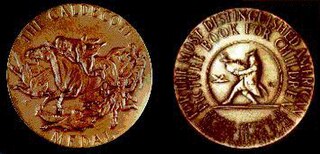
The Randolph Caldecott Medal, frequently shortened to just the Caldecott, annually recognizes the preceding year's "most distinguished American picture book for children". It is awarded to the illustrator by the Association for Library Service to Children (ALSC), a division of the American Library Association (ALA). The Caldecott and Newbery Medals are considered the most prestigious American children's book awards. Besides the Caldecott Medal, the committee awards a variable number of citations to runners-up they deem worthy, called the Caldecott Honor or Caldecott Honor Books.

Plymouth Colony was the first permanent English colony in New England from 1620 and the third permanent English colony in America, after Newfoundland and the Jamestown Colony. It was settled by the passengers on the Mayflower at a location that had previously been surveyed and named by Captain John Smith. The settlement served as the capital of the colony and developed as the town of Plymouth, Massachusetts. At its height, Plymouth Colony occupied most of what is now the southeastern portion of Massachusetts. Many of the people and events surrounding Plymouth Colony have become part of American folklore, including the American tradition of Thanksgiving and the monument of Plymouth Rock.
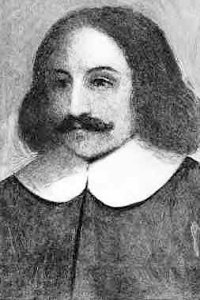
William Bradford was an English Puritan Separatist originally from the West Riding of Yorkshire in Northern England. He moved to Leiden in Holland in order to escape persecution from King James I of England, and then emigrated to the Plymouth Colony on the Mayflower in 1620. He was a signatory to the Mayflower Compact and went on to serve as Governor of the Plymouth Colony intermittently for about 30 years between 1621 and 1657. He served as a commissioner of the United Colonies of New England on multiple occasions and served twice as president. His journal Of Plymouth Plantation covered the years from 1620 to 1646 in Plymouth.

Tisquantum, more commonly known as Squanto, was a member of the Patuxet tribe of Wampanoags, best known for being an early liaison between the Native American population in Southern New England and the Mayflower Pilgrims who made their settlement at the site of Tisquantum's former summer village, now Plymouth, Massachusetts. The Patuxet tribe had lived on the western coast of Cape Cod Bay, but were wiped out by an epidemic, traditionally assumed to be smallpox brought by previous European explorers, recent findings suggest however, that the disease was rather, Leptospirosis, a bacterial infection transmitted to humans typically via "dirty water" or soil contaminated with the waste product of infected, often domestic animals.
Taro Yashima was a Japanese-American artist and children's book author. He immigrated to the United States in 1939 and assisted the U.S. war effort.

Ed Tse-chun Young was a Chinese-born American illustrator and writer of children's picture books and tai chi instructor. He has received many awards and recognitions, including the Caldecott Medal and Lifetime Achievement awards for his contributions as a children's illustrator.
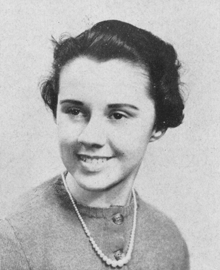
Marcia Joan Brown was an American writer and illustrator of more than 30 children's books. She won three annual Caldecott Medals from the American Library Association, six Caldecott Medal honors as an illustrator, recognizing the year's best U.S. picture book illustration, and the ALA's Children's Literature Legacy Award in 1992 for her career contribution to children's literature. This total of nine books with awards and honors is more than any other Caldecott-nominated illustrator. Many of her titles have been published in translation, including Afrikaans, German, Japanese, Spanish, and Xhosa-Bantu editions. Brown is known as one of the most honored illustrators in children's literature.

Roger Antoine Duvoisin was a Swiss-born American writer and illustrator best known for children's picture books. He won the 1948 Caldecott Medal for picture books and in 1968 he was a highly commended runner-up for the biennial, international Hans Christian Andersen Award for children's illustrators.

Katherine Milhous (1894–1977) was an American artist, illustrator, and writer. She is known best as the author and illustrator of The Egg Tree, which won the 1951 Caldecott Medal for U.S. picture book illustration. Born into a Quaker family active in the printing industry in Philadelphia, Milhous is also known for her graphic designs for the Works Progress Administration (WPA). Her work has been exhibited at the 1939 New York World's Fair and at the Pennsylvania Academy of the Fine Arts.

Maud Fuller Petersham and Miska Petersham were American writers and illustrators who helped set the direction for illustrated children's books that followed. The Petershams worked closely with such pioneering children's book editors as Louise Seaman Bechtel and May Massee, and with such innovative printers as Charles Stringer and William Glaser. They worked as a seamless partnership for more than five decades. Both prolific and versatile, they produced illustrations for more than 120 trade books and textbooks, anthologies, and picture books. Of the 50 books they both wrote and illustrated, many were recognized with important awards or critical acclaim. They are known for technical excellence, exuberant color, and the introduction of international folk and modernist themes.
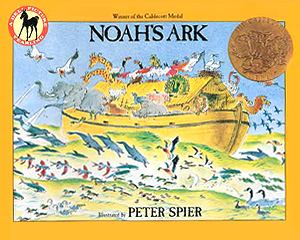
Noah's Ark is a children's picture book written and illustrated by Peter Spier, first published by Doubleday in 1977. The text includes Spier's translation of "The Flood" by Jacobus Revius, a 17th-century poem telling the Bible story of Noah's Ark. According to Kirkus Reviews, the poem comprises sixty three-syllable lines such as "Pair by pair". "Without revising or even enlarging on the old story, Spier fills it in, delightfully." In a retrospective essay about the Caldecott Medal-winning books from 1976 to 1985, Barbara Bader described the book as "at once elaborate and feeble" and Revius' poem as "neither particularly suited to children nor eloquent in itself."
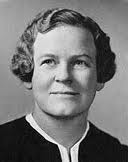
Alice Dalgliesh was a naturalized American writer and publisher who wrote more than 40 fiction and non-fiction books, mainly for children. She has been called "a pioneer in the field of children's historical fiction". Three of her books were runners-up for the annual Newbery Medal, the partly autobiographical The Silver Pencil, The Bears on Hemlock Mountain, and The Courage of Sarah Noble, which was also named to the Lewis Carroll Shelf Award list.
Beatrice Schenk de Regniers was an American writer of children's picture books.
Helen Sewell was an American illustrator and writer of children's books. She won a Caldecott Medal Honor as illustrator of The Thanksgiving Story by Alice Dalgliesh and she illustrated several novels that were runners-up for the Newbery Medal.

Mayflower was an English sailing ship that transported a group of English families, known today as the Pilgrims, from England to the New World in 1620. After 10 weeks at sea, Mayflower, with 102 passengers and a crew of about 30, reached what is today the United States, dropping anchor near the tip of Cape Cod, Massachusetts, on November 21 [O.S. November 11], 1620.

The Patuxet were a Native American band of the Wampanoag tribal confederation. They lived primarily in and around modern-day Plymouth, Massachusetts, and were among the first Native Americans encountered by European settlers in the region in the early 17th century. Most of the population subsequently died of epidemic infectious diseases. The last of the Patuxet – an individual named Tisquantum, who played an important role in the survival of the Pilgrim colony at Plymouth – died in 1622.

Olivia is a fictional pig character in a series of children's picture books written and illustrated by the late Ian Falconer, the first entry of which was published in 2000. An animated television series, Olivia, inspired by the character premiered in 2009.

The Courage of Sarah Noble by Alice Dalgliesh is the story of a young girl who travels with her father into Connecticut during the early 18th century, and her experiences with the native Schaghticoke. It was published in 1954 and received a Newbery Honor Award.
Hildegard Woodward was the author and illustrator of many children's books, two of which were awarded a Caldecott Honor. Woodward's art was not restricted to children's books; her portfolio includes numerous works of fiction and humor for adults. Although most noted for her watercolor illustrations, she painted in oil and was a children's portrait artist.
Saints & Strangers is an American drama television two-part miniseries. It tells the story of the Mayflower voyage and chronicles the Pilgrims' first year in America and the first Thanksgiving in 1621. The program aired on the National Geographic Channel and premiered on November 22, 2015.















